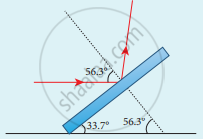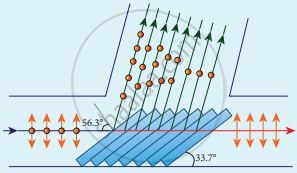Advertisements
Advertisements
प्रश्न
Discuss about pile of plates.
उत्तर
- The phenomenon of polarisation by reflection is used in the construction of pile of plates.
- It consists of a number of glass plates placed one over the other in a tube
- The plates are inclined at an angle of 33.7°(90° – 56.3°) to the axis of the tube. A beam of unpolarised light is allowed to fall on the pile of plates along the axis of the tube. So, the angle of incidence of light will be at 56.3° which is the polarising angle for glass.


Pile of plates - The vibrations perpendicular to the plane of incidence are reflected at each surface and those parallel to it are transmitted.
- The larger the number of surfaces, the greater is the intensity of the reflected plane polarised light.
- The pile of plates is used as a polarizer and also as an analyser.
APPEARS IN
संबंधित प्रश्न
If the polarising angle for a given medium is 60°, then the refractive index of the medium is.................
If the critical angle of a medium is sin-1(3/5), find the polarising angle.
Show, using a simple polaroid, that light waves are transverse in nature. Intensity of light coming out of a polaroid does not change irrespective of the orientation of the pass axis of the polaroid. Explain why.
How does one demonstrate, using a suitable diagram, that unpolarised light when passed through a Polaroid gets polarised?
Show, with the help of a diagram, how unpolarised sunlight gets polarised due to scattering.
Two polaroids P1 and P2 are placed with their pass axes perpendicular to each other. An unpolarised light of intensity Io is incident on P1. A third polaroid P3 is kept in between P1 and P2 such that its pass axis makes an angle of 45° with that of P1. Determine the intensity of light transmitted through P1, P2 and P3
Show, via a suitable diagram, how unpolarised light can be polarised by reflection.
When a low flying aircraft passes overhead, we sometimes notice a slight shaking of the picture on our TV screen. Suggest a possible explanation.
The refractive indices of water for red and violet colours are 1.325 and 1.334 respectively.
Find the difference between the velocities of rays for these two colours in water. (c = 3 × 108 m/s)
What is the value of refractive index of a medium of polarising angle 60°?
Show using a proper diagram how unpolarised light can be linearly polarised by reflection from a transparent glass surface.
Unpolarised light is incident on a polaroid. How would the intensity of transmitted light change when the polaroid is rotated?
A ray of ordinary light is travelling in air. It is incident on air glass pair at a polarising angle of 56°. Find the angle of refraction in glass.
Discuss polarisation by selective absorption.
What is partially polarised light?
Discuss about Nicol prism.
An unpolarised light of intensity 32 Wm-2 passes through three Polaroids such that the axes of the first and the last Polaroids are at 90°. What is the angle between the axes of the first and middle Polaroids so that the emerging light has an intensity of only 3 Wm-2?
Polarisation of light is the only phenomenon that establishes ______.
Can reflection result in plane polarised light if the light is incident on the interface from the side with higher refractive index?
To ensure almost 100 per cent transmissivity, photographic lenses are often coated with a thin layer of dielectric material. The refractive index of this material is intermediated between that of air and glass (which makes the optical element of the lens). A typically used dielectric film is MgF2 (n = 1.38). What should the thickness of the film be so that at the center of the visible spectrum (5500 Å) there is maximum transmission.
